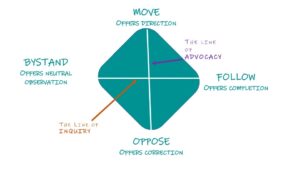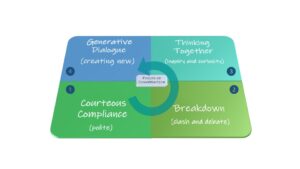Communicative Competence Helps You Get Stuff Done
Last time I summarized dialogue from an actual team meeting to introduce you to one model of communicative competence: Otto Scharmer’s fields of communication.
Today I want to share another model that works hand in hand with Scharmer’s: David Kantor’s four-player model. Using these two models together, you can bring your team to communicative competence—which means you’ll work together to get stuff done.
(click to enlarge)
The roles aren’t fixed; you don’t need one Mover, one Opposer, one Follower, and one Bystander. Rather, any one person can make any of these four plays. When all four of Kantor’s players get together, Scharmer’s generative dialogue can result.
At the risk of redundancy, I’m going to summarize the dialogue from the previous blog, just so we’ll have it right here. This time, I’ll label the plays.
Claire MOVES: We need to focus more on profitability. Here’s my spreadsheet to help us decide whether projects are likely to be profitable.
Cameron OPPOSES: Is profitability all we care about? What about creativity?
Phil FOLLOWS: Ultimately, we’re here to make money.
Gloria OPPOSES: But if we want to keep getting bigger and better projects, we have to set ourselves apart.
Manny BYSTANDS: So I’m hearing agreement that we want more than just profitability. What I’m not hearing is agreement about what other things to include and how to measure them.
The Move-Oppose back-and-forth–which actually went on quite a bit longer than I’m letting on–is a perfect example of Scharmer’s breakdown. The term sounds negative, but in fact breakdown is a step along the way toward generative dialogue–which is our goal in any meeting.
Breakdown beats courteous compliance hands down. Courteous compliance results when one person Moves and everyone else Follows, whether they agree or not. That would have gone like this:
Claire MOVES: We need to focus on profitability. Here’s my spreadsheet.
Cameron FOLLOWS (with a hidden OPPOSE): [thinking] What about creativity? [speaking] OK, when do we need to start using it? I’ve got a couple of prospects right now that might not meet this standard.
Phil FOLLOWS: [thinking] Cameron can be such a diva! [speaking] This is great! We’re here to make money, after all.
Gloria FOLLOWS: [thinking] But if we want to keep getting bigger and better projects, we have to set ourselves apart. [speaking] Sure, profitability is important.
…And so on, until Jay wraps up with “Great, everyone agrees! We’ll start using Claire’s spreadsheet next week.”
You know what happens to Claire’s spreadsheet, right? It gets used a few times, and then it doesn’t. The problem with courteous compliance is that the resistance it masks inevitably resurfaces down the road.
So breakdown is necessary for the next fields of conversation, thinking together and generative dialogue. Those fields in turn are necessary for durable decisions that people actually implement.
The play that got the team thinking together was Manny’s Bystand. Obviously continued Move-Oppose-Move-Oppose can’t be productive. You’ve been in meetings where two sides simply kept repeating their arguments more loudly and heatedly. Nothing good can happen until something interrupts.
In the four-player model, that interruption is a Bystand or a Follow. Bystands and Follows are on the “line of inquiry,” while Move and Oppose are on the “line of advocacy.” In a conversation where two sides are advocating for their positions, someone needs to come in with an inquiry.
If I had a lot more space, I’d show you how that worked in the meeting I’ve been describing to bring the team to generative dialogue.
But I’ve taken enough of your time for now. To see how you can use these two models to make your team more productive and creative, please join my webinar Building Communicative Competence on May 18.




